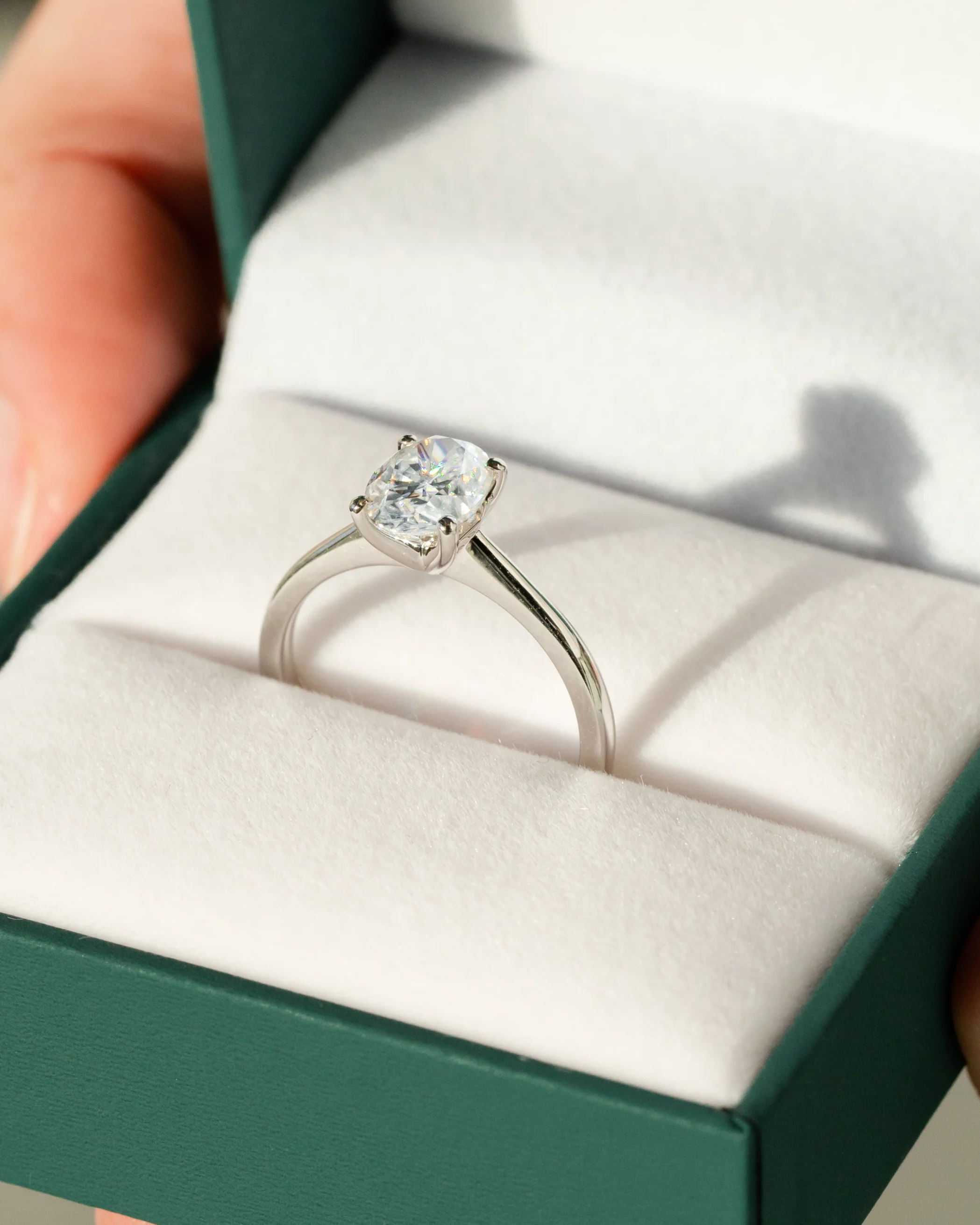
The differences between a diamond and a moissanite ring are subtle, but noticeable once you know what you are looking for.
From a scientific point of view, diamonds are made from pure carbon and are the hardest known material on Earth. Meanwhile, moissanite is composed of silicon carbide and is known for its durability. However, side by side, it can be difficult to tell these precious gemstones apart.
It takes a keen eye and a bit of gemological knowledge to spot the difference, and even then, a trained eye can be fooled! If you’re trying to decide between moissanite and diamond for your engagement ring, read on the discover the differences between these two fascinating stones.
Brilliance and fire in moissanite and diamond
Brilliance and fire are the most obvious differences when comparing moissanite and diamond. Brilliance is the small flashes of white light that you can see being reflected from inside the stone back to you, and fire is the way white light disperses into different colours as it travels through the stone to give you that rainbow effect.
Put simply, when light enters a clear substance like moissanite, it gets slowed down, which causes it to bend or refract before it speeds up again as it leaves the substance. Moissanite has a higher Refractive Index than diamond, which means that moissanite will bend light more, and therefore show higher levels of brilliance and fire.
When sunlight hits a moissanite stone, it sparkles in a rainbow, almost disco ball pattern that is beautiful to behold. A diamond, on the other hand, refracts light in more of a kaleidoscope pattern which sticks to a more white, blue, grey sparkle in the gem. The bigger the moissanite stone is, the easier it is to tell the difference in brilliance and fire. However, in most cases, people will simply be admiring your moissanite engagement ring for the beautiful piece that it is, and not just checking the sparkle to see what type of gemstone it is.
In the image below, which engagement ring is a moissanite round solitaire, and which one is a diamond round solitaire? Can you tell the difference in their brilliance or fire? Read through to the end of the blog for the answer!
.jpg)

The colour of moissanite vs diamond
A colourless moissanite stone and a diamond are slightly different in colour, but the difference is so small that it is only noticeable when comparing moissanite and diamond side by side. A diamond will have no traces of other colours, whereas a moissanite stone may have subtle traces of grey or yellow that can be seen in certain lights. Unless you have a moissanite ring and a diamond ring side by side, this difference is impossible for regular people to notice.
In contrast, being a lab grown stone, moissanite is easy to colour, allowing you greater flexibility in design with a moissanite engagement ring. Some popular colours are pink, blue, yellow, purple, green, and grey, but a moissanite stone can be coloured to your heart’s desire.
.jpg)
Placed side by side, can you tell the difference between a diamond and a moissanite gemstone? Read through to the end of the blog for the answer!
The clarity of moissanite vs diamond
This is a popular discussion point when comparing moissanite vs diamond, but one that people will not be able to spot while looking at your engagement ring. Moissanite is lab grown, so they generally have almost no flaws . Diamond, on the other hand, is often mined and many of the gems will have flaws, meaning that unless you want to pay top dollar, the gem in your engagement ring will have imperfections.
Our moissanite stones have a clarity of VVS1-2, which stands for very very slightly included. An inclusion is a small imperfection trapped within the stone which can block the path of light through the stone, causing it to show less brilliance and fire, and look more dull. A grading of VVS1-2 is nearly perfect on the clarity grading scale, meaning your stone should sparkle and shine beautifully. Finding a diamond, however, with a VVS1-2 grading is quite difficult and extremely expensive. For comparison, where you could purchase a VVS1-2 7.5mm (1.50ct) round cut moissanite
for around $900 AUD, those same specifications for a diamond would set you back at least $8000 AUD.
Discover our premium moissanite engagement rings
Cullen Jewellery believes in creating extraordinary client experiences while respecting tradition and artisanal skill in fine jewellery making. We are passionate about integrating cutting-edge technology with ethical and sustainable practices that benefit both people and the planet.
We believe moissanite is a truly beautiful precious gemstone with great brilliance and fire. However, like any precious gemstone, moissanite requires care and maintenance to avoid buildup over time.
Moissanite shines bright with a rainbow sparkle, offering a budget-friendly option without sacrificing beauty - all it needs is a little TLC.
For the proposal that can’t wait, explore our ready to ship engagement rings or create your lab grown diamond, moissanite or lab grown sapphire engagement ring with our engagement ring builder .
Choose a Moissanite Engagement Ring SettingAnswers
In the first image, we stacked the Anna moissanite engagement ring with our delicate Odette wedding band. In this image, the moissanite round solitaire stone clearly exhibits a more colourful fire. In the second image, we paired the Amanda 6 claw pave diamond solitaire with the sweet and simple Ashton wedding band.
In the third image, we placed the Daisy diamond solitaire ring on the left and the Daisy moissanite solitaire ring on the right.